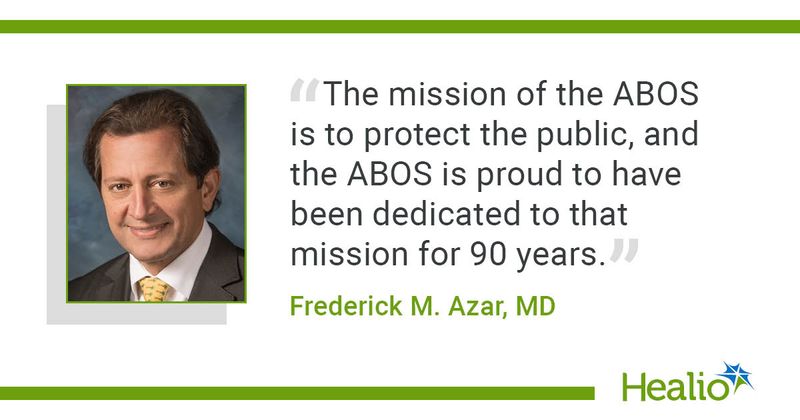American Board of Orthopaedic Surgery: Doing the right thing for 90 years
Click Here to Manage Email Alerts
Key takeaways:
- Since its founding, the ABOS Board of Directors has always made it a mission to “do the right thing.”
- The ABOS is continuing to look for ways to improve all programs and processes.
Ninety years ago, the American Board of Orthopaedic Surgery was founded in Chicago at the Palmer House Hotel – the location where the ABOS still administers the ABOS Part II Oral and Oral Recertification Examinations.
Since its founding, the ABOS Board of Directors has always made it a mission to “do the right thing.” That phrase is often used when the board has a meeting and is contemplating a change. It is so ingrained into our actions that for the 75th anniversary, then-ABOS executive director G. Paul DeRosa, MD, titled the book he wrote about the anniversary, Doing the Right Thing.

Changing landscape
Doing the right thing does not just apply to developing and modifying programs to make sure they are relevant and not overly burdensome to orthopedic surgeons. It also applies to our patients. The mission of the ABOS is to protect the public, and the ABOS is proud to have been dedicated to that mission for 90 years.
While the ABOS continues to adapt to a changing landscape, many important aspects of board certification in the 1930s are still part of the ABOS today. For instance, surgical case lists and peer review have been part of the ABOS evaluation processes since its founding. In the beginning, the ABOS required the submission of 25 cases. The ABOS now requires candidates to submit 6 months of surgical cases for initial board certification. The ABOS developed and improved the ABOS Scribe Case List System for applicants to enter their surgical cases on a password-protected site. During the last few years, we have worked hard to streamline the system and make the process clear for surgeons. With peer review, the ABOS emails an electronic survey to evaluating surgeons.
In 1935, the first ABOS Examination for Certification was administered and consisted of three parts:
- clinical portion based upon the examination of the patient;
- oral examination conducted by a committee of three members of the ABOS Board; and
- written examination consisting of a single essay question requiring a comprehensive answer to be completed in 1 hour.
In 1943, the ABOS decided to separate the board certification examination into a Part I (Written) Examination and a Part II (Oral) Examination. Eighty years later, we still have two separate examinations that must be completed prior to the awarding of ABOS Board Certification.
For many years, the Part I Written Examination was offered once a year in a Chicago hotel using hard-copy testing booklets, but today is conducted on computers in testing centers across the United States.
The Part II Oral Examination was previously based on standardized cases but was changed to an examination solely based on an individual’s surgical cases. There was a time where examinees had to bring their patient records and images to Chicago in suitcases. However, everything is now completely digital, with all patient records and images being uploaded electronically, and examinees are not allowed to bring anything to the examination.
Recertification
One of the biggest changes during the last 90 years – and possibly one of the most important –was instituting recertification in 1986. Prior to 1986, ABOS Diplomates received a lifetime certification, which the ABOS still honors for those who earned a certificate in that way. However, the ABOS believes surgeons need more than initial certification. Medicine changes quickly, and we need to make sure that the competent surgeon at age 32 years still has the knowledge, skills and behavior to practice safe, ethical and effective orthopedic surgery at age 52 years.
The ABOS has designed and modified recertification, which is now known as the ABOS Maintenance of Certification (MOC) program, that is relevant to ABOS Diplomates while staying true to our mission of protecting the public. ABOS MOC is not just a test but a process, similar to initial board certification in which surgeons submit an application and a case list, and the ABOS secures peer review. In addition, the ABOS requires continuing medical education and self-assessment examination credits, something that most orthopedic surgeons are already doing for state licensure.
An exciting development in the ABOS MOC Program was the 2019 launch of the ABOS Web-Based Longitudinal Assessment (ABOS WLA) Pathway in which ABOS Diplomates select knowledge sources and are assessed on those. It has become the pathway that most ABOS Diplomates select for recertification.
Residency education is another area where the ABOS has made a big change. More than 80 years ago, the ABOS issued its first requirements regarding resident education curriculum and rotation lengths. The ABOS has also been a part of the Accreditation Council for Graduate Medical Education Residency Review Committee for many years. More recently, the ABOS introduced the ABOS Knowledge, Skills, and Behavior (ABOS KSB) Program in which orthopedic surgery residents request surgical skills and professional behavior assessments from faculty. It is part of the competency-based medical education movement, one in which the ABOS is a leader.
Moving forward
The ABOS is continuing to look for ways to improve all programs and processes. Earlier this year, the board created an Artificial Intelligence Task Force. There is a lot of excitement for AI, but there are limits and security issues to be addressed as we move forward.
There are other innovations that we cannot even imagine that may be around the horizon. But before any changes are implemented, the ABOS Board will make sure that we are doing the right thing.
Reference:
https://www.abos.org/about/history
